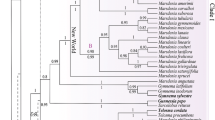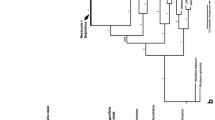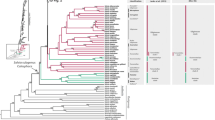Abstract
Salvia subgenus Calosphace (Lamiaceae) is economically and ethnomedicinally significant and comprised of more than 500 species. Although strongly supported as monophyletic, it has received no comprehensive systematic research since the initial establishment of 91 taxonomic sections in 1939. Representative taxa of 73 sections of Calosphace were sampled to investigate the phylogenetic relationships and identify major lineages using chloroplast (intergenic spacer psbA-trnH) and nuclear ribosomal DNA (internal transcribed spacer). Phylogenetic analysis of the combined data sets established monophyly of seven sections (Blakea, Corrugatae, Erythrostachys, Hastatae, Incarnatae, Microsphace, and Sigmoideae) and four major lineages (S. axillaris, “Hastatae clade”, “Uliginosae clade”, and “core Calosphace”). Sections spanning two or more centers of diversity are not supported by our results; rather, supported relationships exhibit significant geographic structure. Mexico is supported as the geographic origin of Calosphace, and no more than seven dispersal events to South America are required to account for current disjunct distributions.




Similar content being viewed by others
References
Alziar G (1988–1993) Catalogue synonymique des Salvia L. du monde (Lamiaceae). I–VI. Biocasme Mesogéen 5:87–136; 6:79–115, 163–240; 7:59–109; 9:413–497; 10:33–117
Baker FK, Lutzoni FM (2002) The utility of the incongruence length difference test. Syst Biol 51:625–637
Bentham G (1832) Labiatarum genera et species. Ridgeway, London
Bentham G (1848) Labiatae. In: De Candolle A (ed) Prodromus systematis naturalis regni vegetabilis, vol 12, pp 262–358
Bentham G (1876) Labiatae. In: Bentham G, Hooker J (eds) Genera plantarum, vol 2, pp 1160–1222
Briquet J (1897) Labiatae. In: Engler A, Prantl K (eds) Die natürlichen pflanzenfamilien, vol 4(3a), pp 183–373
Cantino PD (1992) Evidence for a polyphyletic origin of the Labiatae. Ann Missouri Bot Gard 79:361–379
Cantino PD, Sanders W (1986) Subfamilial classification of the Labiatae. Syst Bot 11:163–185
Darlu P, Lecointre G (2002) When does the incongruence length difference test fail? Mol Biol Evol 19:432–437
El-Gazzar A, Watson L, Williams WT, Lance GN (1968) The Taxonomy of Salvia: a test of two radically different numerical methods. Bot J Linn Soc 60:237–250
Epling C (1938) The Californian Salvias. Ann Missouri Bot Gar 25:95–188
Epling C (1939) A revision of Saliva, subgenus Calosphace. Repertorium Specierum Novarum Regni Vegetabilis, Beihefte, vol 110
Epling C (1940a) Supplementary notes on American Labiatae. Bull Torrey Bot Club 67:509–534
Epling C (1940b) Labiatae. In: Woodson RE, Schery RW (eds) Flora of Panama IV, Ann Missouri Bot Gar., vol 27, pp 337–338
Epling C (1941) Supplementary notes on American Labiatae-II. Bull Torrey Bot Club 68:552–568
Epling C (1944) Supplementary notes on American Labiatae-III. Bull Torrey Bot Club 71:484–497
Epling C (1947) Supplementary notes on American Labiatae-IV. Bull Torrey Bot Club 74:512–518
Epling C (1951) Supplementary notes on American Labiatae-V. Brittonia 7:129–142
Epling C (1960) Supplementary notes on American Labiatae-VII. Brittonia 12:140–150
Epling C, Játiva-M C (1963) Supplementary notes on American Labiatae-VIII. Brittonia 15:366–376
Epling C, Játiva-M C (1966) Supplementary notes on American Labiatae-IX. Brittonia 18:255–265
Epling C, Játiva-M C (1968) Supplementary notes on American Labiatae-X. Brittonia 20:295–313
Epling C, Mathias ME (1957) Supplementary notes on American Labiatae-VI. Brittonia 8:297–313
Espejo-Serna A, Ramamoorthy TP (1993) Revision taxonomica de Salvia seccion Sigmoideae (Lamiaceae). Acta Bot Mex 23:65–102
Farris JS, Köllersjo M, Kluge AG, Bult C (1995) Constructing a significance test for incongruence. Syst Bot 44:570–572
Fernández-Alonso JL (1995a) Estudios en Labiatae de Colombia I. Novedades en los generos Salvia e Hyptis. Rev Acad Colombiana de Ciencias Exactas Fisicas y Naturales 19:469–480
Fernández-Alonso JL (1995b) Estudios en Labiatae de Colombia II. Novedades en Salvia sect. Longipes Epl Ann Jard Bot Madrid 53:41–46
Fernández-Alonso JL (1995c) Una nueva especie de Salvia (Labiatae) de Colombia. Ann Jard Bot Madrid 52:159–162
Fernández-Alonso JL (2002) Estudios en Labiatae de Colombia III. Novedades en Lepechinia Willd., Salvia L. y Satureja L. Ann Jard Bot Madrid 59:344–348
Fernández-Alonso JL (2003) Estudios en Labiatae de Colombia IV. Novedades en Salvia y sinopsis de las secciones Angulatae y Purpureae. Caldasia 25:235–281
Fitch WM (1971) Toward defining the course of evolution: minimum change for a specific tree topology. Syst Zool 20:406–416
Harley RM, Heywood CA (1992) Chromosome Numbers in Tropical American Labiatae. In: Harley RM, Reynolds T (eds) Advances in Labiate Science. Royal Botanic Gardens, Kew, pp 211–246
Huelsenbeck JP, Ronquist F (2001) MRBAYES: Bayesian inference of phylogenetic trees. Bioinformatics 17:754–755
Jenks AA (2009) Systematics and ethnobotany of Salvia subgenus Calosphace and origins of the hallucinogenic sage, Salvia divinorum. Ph.D. dissertation, University of California, Riverside
Jenks AA, Walker JB, Kim S-C (2011) Evolution and origins of the Mazatec hallucinogenic sage, Salvia divinorum (Lamiaceae): a molecular phylogenetic approach. J Plant Res 124:593–600
Kaufmann M, Wink M (1994) Molecular systematics of the Nepetoideae (Family Labiatae): phylogenetic implications from rbcL gene sequences. Z Naturforsch 49c:635–645
Kim S-C, Crawford DJ, Jansen RK, Santos-Guerra A (1999) The use of a noncoding region of chloroplast DNA in phylogeny of the subtribe Sonchinae (Asteraceae). Plant Syst Evol 215:85–99
Linnaeus C (1753) Salvia. Species Plantarum 1: 23-27
Maddison DR, Maddison WP (2003) MacClade 4.06: analysis of phylogeny and character evolution. Sinauer, Sunderland
Neisess KR (1983) Evolution, systematics, and terpene relationships of Salvia Section Audibertia. Ph.D. dissertation. University of California, Riverside
Nowicke JW, Epling C (1969) Labiate. In: Woodson Jr RE, Schery RW et al (eds) Flora of Panama. Part IX. Family 169. Annals of the Missouri Botanical Garden, vol 56, pp 71–111
Nylander JAA (2004) MrModeltest 2.2. Computer program and documentation distributed by the author. Evolutionary Biology Centre, Uppsala University
Peterson KM (1978) Systematic studies of Salvia L. subgenus Calosphace (Benth.) Benth. in Benth. & Hook. Section Farinaceae (Epling) Epling (Lamiaceae). Ph.D. dissertation, University of Maryland, College Park
Ramamoorthy TP (1984a) A new species of Salvia (Lamiaceae) from Mexico. Brittonia 36:297–299
Ramamoorthy TP (1984b) A new species of Salvia (Lamiaceae) from the Sierra de Los Tuxtlas, Mexico. Plant Syst Evol 146:141–143
Ramamoorthy TP (1984c) Notes on Salvia (Labiatae) in Mexico, with three new species. J Arnold Arboretum 65:135–143
Ramamoorthy TP (1984d) Typifications in Salvia (Lamiaceae). Taxon 33:322–324
Ramamoorthy TP, Elliott M (1998) Mexican Lamiaceae: diversity, distribution, endemism, and evolution. In: Ramamoorthy TP, Bye R, Lot A, Fa J (eds) Biological diversity of Mexico: origins and distribution. Universidad Nacional Autónoma de México, Instituto de Biologia, Mexico, pp 501–525
Ramamoorthy TP, Lorence DH (1987) Species vicariance in the Mexican flora and description of a new species of Salvia (Lamiaceae). Mus Nat d’Histoire Nat Paris, 4. Adansonia 9B:167–175
Ramamoorthy TP, Esquivel B, Sánchez AA, Rodriguez-Hahn L (1988) Phytogeographical significance of the occurrence of abietane type diterpenoids in Salvia sect. Erythrostachys (Lamiaceae). Taxon 37:908–912
Reisfield AS (1987) Systematic studies in Salvia L. (Lamiaceae) with special emphasis on subgenus Calosphace (Benth.) Benth. section Dusenostachys Epl. Masters thesis, University of Wisconsin, Madison
Ronquist F, Huelsenbeck JP (2003) MrBayes 3: Bayesian phylogenetic inference under mixed models. Bioinformatics 19:1572–1574
Santos EP (1991) Genre Salvia L. sous-genre Calosphace (Benth.) Benth. section Nobilies (Benth.) Epl. (Labiateae). Bradea 5:436–454
Santos EP (1993) Duas Especies novas de Salvia L. (Lamiaceae) do Brasil. Bradea 6:259–264
Santos EP (1994) Contribution a la systematique du genre Salvia L. sug. Calosphace (Benth.) Benth. (Lamiaceae): description de deux especes nouvelles du Bresil. Mus Nat d’Histoire Nat, Paris, 4. Adansonia 16:155–161
Santos EP (1995) Phylogenie et phytogeographie du genre Salvia L. section Rudes (Benth.) Epl. (Lamiacees). Biogeographica 71:15–32
Santos EP (1996) Revision de la section Rudes (Benth.) Epling du genre Salvia L., sous- genre Calosphace (Benth.) Benth. (Labiatae). Candollea 51:19–57
Santos EP (2004) Notes on Salvia sect. Secundae (Lamiaceae) and two new species from Brazil. Kew Bull 59:285–290
Santos EP, Harley RM (2004) Notes on Salvia section Nobiles (Lamiaceae) and two new species from Brazil. Kew Bull 59:103–109
Standley PC, Williams LO (1973) Flora of Guatemala. Fieldiana Bot 24:273–301
Swofford DL (2002) PAUP*. Phylogenetic analysis using parsimony (*and other methods). Version 4. Sinauer Associates, Sunderland
Takano A, Okada H (2011) Phylogenetic relationships among subgenera, species, and varieties of Japanese Salvia L. (Lamiaceae). J Plant Res 124:245–252
Torke BM (2000) A revision of Salvia sect. Ekmania (Lamiaceae). Brittonia 52:265–302
Turner BL (1996) Synopsis of section Axillaris of Salvia (Lamiaceae). Phytologia 81:16–21
Wagstaff SJ, Olmstead RG, Cantino PD (1995) Parsimony analysis of cpDNA restriction site variation in subfamily Nepetoideae (Labiatae). Am J Bot 82:886–892
Wagstaff SJ, Hickerson L, Spangler R, Reeves PA, Olmstead RG (1998) Phylogeny in Labiatae sl, inferred from cpDNA sequences. Plant Syst Evol 209:265–274
Walker JB (2006) Systematics of genus Salvia (Lamiaceae). Ph.D. Dissertation, University of Wisconsin, Madison
Walker JB, Sytsma KJ (2007) Staminal evolution in the genus Salvia (Lamiacaee): molecular phylogenetic evidence for multiple origins of the staminal lever. Ann Bot 100:375–391
Walker JB, Sytsma KJ, Treutlein J, Wink M (2004) Salvia (Lamiaceae) is not monophyletic: implications for the systematics, radiation, and ecological specializations of Salvia and Tribe Mentheae. Am J Bot 91:1115–1125
White TJ, Bruns T, Lee S, Taylor J (1990) Amplification and direct sequencing of fungal ribosomal RNA genes for phylogenetics. In: Innis MA, Gelfand GH, Sninsky JJ, White TJ (eds) PCR protocols: A guide to methods and applications. Academic Press, San Diego, pp 315–322
Wood JRI, Harley RM (1988) The genus Salvia (Labiatae) in Colombia. Kew Bull 44:211–278
Xifreda C (1999) Lamiaceae. In: Zuloaga F, Morrone O (eds) Catalogo de las Plantas Vasculares de la republica argentina II. Monographs in systematic botany from the Missouri Botanical Garden, St. Louis, Missouri, pp 768–781
Acknowledgments
This paper represents a portion of PhD dissertation submitted to the University of California at Riverside for partial fulfillment of the first author’s doctoral degree. We thank Giles Waines and Travis Columbus for technical advise and the following herbaria for loaning specimens: University of Wisconsin, Madison Herbarium (WIS), Missouri Botanic Garden (MO), Johannes Gutenberg-Universität, Germany (MJG), and Field Museum of Natural History (F). This project was supported by grants from The Botanical Society of America and the Pacific Rim Association of the University of California.
Author information
Authors and Affiliations
Corresponding authors
Appendix
Appendix
List of taxa sampled in this study with voucher information (collector, collection number, and herbarium where specimen is deposited) or literature citation for previous published sequences. Sequences are listed alphabetically by genus and species. Herbarium acronyms: UCR = University of California, Riverside, USA; WIS = University of Wisconsin, Madison, USA; MO = Missouri Botanic Garden, USA; F = Field Museum of Natural History, USA; MJG = Johannes Gutenberg-Universaität Mainz, Germany. Other abbreviations: cult. = from cultivated material; UCRBG = University of California, Riverside, Botanic Garden, Riverside, CA, USA; WSN = Richard DuFresne’s World of Salvias Nursery, Star, NC, USA.
Dorystaechas hastata Boiss. & Heldr. ex Benth., 1972-0177D (MJG); Salvia adenophora Fern., Crone 7/8/00 (MJG); S. agnes Epl., B. Carlson s/n (UCR); S. alamosana Rose, J. Walker 3040 (WIS); S. albo - caerulea Lind., Walker (2006); S. alborsea Epl. & Játiva-M., Sagastegui et al. 15910 (F); S. amarissima Ort., Lott 3404 (UCR); S. amplifrons Briq., P. Wester 141 (MJG); S. angulata Benth., Walker (2006); S. angustiarum Epl., Peterson 629 (WIS); S. arbuscula Fern., Tenorio 16911 (WIS); S. areolata Epl., Cahill 2966 (UCR); S. articulata Epl., Walker (2006); S. aspera Mart. & Gal., J. Walker 3021 (WIS); S. atrocyanea Epl., P. Wester 3 (MJG); S. axillaris Moc. & Sessé ex Benth., Breedlove 59702 (WIS); S. azurea Michx. ex Lam., J. Walker 3222 (WIS); S. ballotaeflora Benth., J.B. Walker 2547 (WIS); S. bangii Rusby, P. Wester 10 (MJG); S. betulaefolia Epl., Van Devender s/n (UCR); S. blepharophylla Brandegee, cult., UCRBG; S. brevipes Benth., Walker (2006); S. cacaliifolia Benth., J.B. Walker 1203 (WIS); S. californica Brandegee, J.B. Walker 2520 (WIS); S. candicans Mart. & Gal., J. Walker 3001 (WIS); S. cardinalis Kunth, cult., WSN; S. carnea var. carnea Kunth, Boeke 2366 (MO); S. cedrosensis Greene, cult., Rancho Santa Ana Botanic Garden, CA, USA; S. cerradicola Santos, Walker (2006); S. cf. pusilla Fern., Crone 29/7/00 (MJG); S. cf. stolonifera Benth., J. Walker 3002 (WIS); S. chamaedryoides Cav., J. Walker 2009 (WIS); S. chapalensis Briq., J. Walker 3029 (WIS); S. chiapensis Fern., cult., UCRBG; S. chionophylla Fern., cult., WSN; S. cinnabarina Mart. & Gal., J. Walker 3030 (WIS); S. clinopodioides Kunth, Iltis 28770 (WIS); S. coahuilensis Fern., cult., UCRBG; S. coccinea Juss. ex Murr.,, cult., UCRBG; S. concolor Lamb. ex Benth., Reisfield 1286 (WIS); S. confertiflora Pohl, 1959-9166A (WIS); S. corrugata Vahl., Jenks 256 (UCR); S. cuatrecasana Epl., Walker (2006); S. curtiflora Epl., P. Wester 294 (MJG); S. cyanicalyx Epl., Schmidt-Lebuhn 578 (MJG); S. discolor Kunth, J.B. Walker 2546 (WIS); S. disjuncta Fern., J. Walker 3018 (WIS); S. divinorum Epl. & Játiva-M., Jenks 237 (UCR); S. dombeyi Epl., 1959-9269A (WIS); S. dorisiana Standley, 2000-1632A (WIS); S. elegans Vahl, J.B. Walker 1204 (WIS); S. erythrostoma ssp. isabelina Fernández-A., Fernandez & Castillo 12308 (MO); S. faccidifolia Fern., Reisfield & Sundberg 1212 (MO); S. farinacea Benth., J.B. Walker 2525 (WIS); S. florida Benth., Schmidt-Lebuhn 450 (MJG); S. formosa L’Hérit., Gentry et al. 19240 (F); S. forreri Greene, J.B. Walker 2098 (WIS); S. fruticulosa Benth., Crone 1/8/00 (MJG); S. fulgens Cav., 1967-1496A (WIS); S. gesneraeflora Lindl. & Paxton, cult., UCRBG; S. gilliesii Benth., P. Wester 13 (MJG); S. glechomaefolia Kunth, cult., WSN; S. gracilipes Epl., Steyermark 55997 (F); S. graciliramulos Epl.&Játiva-M., P. Wester 14 (MJG); S. gravida Epl., cult., WSN; S. greatae Brandegee, J.B. Walker 2511 (WIS); S. greggii Gray, cult., UCRBG; S. grewiifolia S. Moore, P. Wester 15 (MJG); S. guaranitica St.Hil. ex Benth., cult., UCRBG; S. haenkei Benth., P. Wester 71 (MJG); S. herbacea Benth., Torres 448 (WIS); S. hilarii Benth., Walker (2006); S. hirtella Vahl, Schmidt-Lebuhn 395 (WIS); S. holwayi Blake, cult., UCRBG; S. inconspicua Benth., J. Walker 3045 (WIS); S. infuscata Epl., Cowan 5011 (UCR); S. involucrata Cav., cult., UCRBG; S. iodantha Fern., cult., UCRBG; S. ionocalyx Epl., cult. (labeled incorrectly as “S. chiapensis”), UCRBG; S. jacobi Epl., cult. (as S. sp. “Blue Chiquita”), WSN; S. karwinskii Benth., cult., UCRBG; S. keerlii Benth., cult., WSN; S. languidula Epl., Sanders 10409 (UCR); S. lasiantha Benth., J. Walker 3009 (WIS); S. lavanduloides Kunth, J. Walker 3044 (WIS); S. leptophylla Benth., 1978-1159A (WIS); S. leucantha Cav., J.B. Walker 1205 (WIS); S. leucocephala Kunth, Walker (2006); S. leucochlamys Epl., Cahill 2963 (UCR); S. lineata Benth., Crone 12/8/00 (MJG); S. littae Vis., cult., WSN; S. lobbii Epl., Schmidt-Lebuhn 475 (MJG); S. longispicata Mart. & Gal., J. Walker 3034 (WIS); S. longistyla Benth., J. Walker 3036 (WIS); S. lycioides Gray, cult. (incorrectly as “S. villosa”), WSN; S. macellaria Epl., J.B. Walker 2047 (WIS); S. macrophylla Benth., Riina 1472 (WIS); S. madrensis Seem., Peterson 738 (WIS); S. melissodora Lag., cult., WSN; S. mellifera Greene, J.B. Walker 2550 (WIS); S. mexicana L., Jenks & Tempchin 224 (UCR); S. mexicana var. minor Benth. (forma alba), cult., WSN; S. mexicana var. minor Benth., cult., UCRBG; S. microphylla Kunth, Jenks & Tempchin 207 (UCR); S. microphylla var. neurepia (Fern.) Epl., 1959-9360 (WIS); S. microphylla var. wislizeni Gray, (UCR); S. miniata Fern., Holst 5895 (MO); S. misella Kunth, J. Walker 3025 (WIS); S. mocinoi Benth., Crone 15/9/00 (MJG); S. moniliformis Fern., Crone 15/9/00 (MJG); S. muelleri Epl., cult., WSN; S. nervata Mart. & Gal., P. Wester 292 (MJG); S. oaxacana Fern., Salinas-T. F-2705 (UCR); S. occidentalis Swartz, J.B. Walker 612 (WIS); S. oppositiflora Ruiz & Pav., Riina 1477 (WIS); S. orbignii Benth., P. Wester 43 (MJG); S. ovalifolia St. Hil. ex Benth., Sytsma 7226 (WIS); S. oxyphora Briq., P. Wester 16 (MJG); S. pansamalensis J.D. Smith, A. Mendez Ton 7353 (WIS); S. parryii Gray, cult., UCRBG; S. patens Cav., 1973-9197 (RBG); S. peninsularis Brandegee, Moran 18786 (MO); S. personata Epl., P. Wester 17 (MJG); S. pichinchensis Benth., Ollgaard & Balslev 9508 (F); S. pinguifolia (Fern.) Woot. & Standl., P. Wester 372 (MJG); S. platystoma Epl., P. Wester 18 (MJG); S. polystachya Ort. (morphotype 1), Jenks & Tempchin 205 (UCR); S. polystachya Ort. (morphotype 2), Jenks & Tempchin 216 (UCR); S. praeclara Epl., P. Wester 32 (MJG); S. prasiifolia Benth., cult. (as S. caudata “El Cielo Blue”), WSN; S . procurrens Benth., Bonif 941 (WIS); S. prunelloides Benth., Crone 15/9/00 (MJG); S. pubescens Benth., J. Walker 3043 (WIS); S. pulchella D.C., cult., WSN; S. purpurea Cav., cult., UCRBG; S. ramosa Brandegee, J. Walker 3008 (WIS); S. recurva Benth., Jenks & Tempchin 212 (UCR); S. reflexa Hornem., J. Walker 3020 (WIS); S. regla Cav., cult., WSN; S. retinerva Briq., Riina 1508a (WIS); S. rhombifolia Ruiz & Pav., J. Wood 2002 (WIS); S. rubescens Kunth, P. Wester 442 (MJG); S. rufula Kunth., Walker (2006); S. rusbyi Britton ex Rusby, P. Wester 31 (MJG); S. rypara Briq., P. Wester 32 (MJG); S. sagittata Ruiz & Pav., cult., UCRBG; S. scabrida Pohl, Pirani 5225 (WIS); S. scutellaroides Kunth, Schmidt-Lebuhn 496 (MJG); S. semiatrata Zucc., cult., WSN; S. sessei Benth., Crone 15/9/00 (MJG); S. setulosa Fern., Crone 30/7/00 (MJG); S. sharpii Epl. & Math., J.B. Walker s/n (WIS); S. sinaloensis Fern., cult., WSN; S. sohrona Briq., P. Wester 34 (MJG); S. speciosa Presl. ex Benth., Soriano 465 (F); S. sphacelaefolia Epl., Lubinsky 264 (UCR); S. splendens Sellow ex Roem. & Schultes, cult., UCRBG; S. stachydifolia Benth., P. Wester 35 (MJG); S. styphelus Epl., Schmidt-Lebuhn 495 (MJG); S. tepicensis Fern., Van Devender 95-470 (UCR); S. thymoides Benth., cult., WSN; S. tiliifolia Vahl, P. Wester 32 (MJG); S. tolimensis Kunth., Walker (2006); S. tomentella Pohl, Walker (2006); S. tortuosa Kunth, Walker (2006); S. tricuspidata Mart. & Gal., J. Walker 3037 (WIS); S. tubifera Cav., P. Wester 231 (MJG); S. tubiflora Smith, cult., WSN; S. uliginosa Benth., 1984-9105B (WIS); S. urica Epl., cult., UCRBG; S. vazquezii Iltis & Ram. (in preparation), P. Wester 196 (MJG); S. venulosa Epl., Wood 5381 (MO); S. vitifolia Benth., J. Walker 3032 (WIS); S. wagneriana Polak., cult., UCRBG; S. xalapensis Benth., Jenks & Tempchin 214 (UCR).
Rights and permissions
About this article
Cite this article
Jenks, A.A., Walker, J.B. & Kim, SC. Phylogeny of New World Salvia subgenus Calosphace (Lamiaceae) based on cpDNA (psbA-trnH) and nrDNA (ITS) sequence data. J Plant Res 126, 483–496 (2013). https://doi.org/10.1007/s10265-012-0543-1
Received:
Accepted:
Published:
Issue Date:
DOI: https://doi.org/10.1007/s10265-012-0543-1




